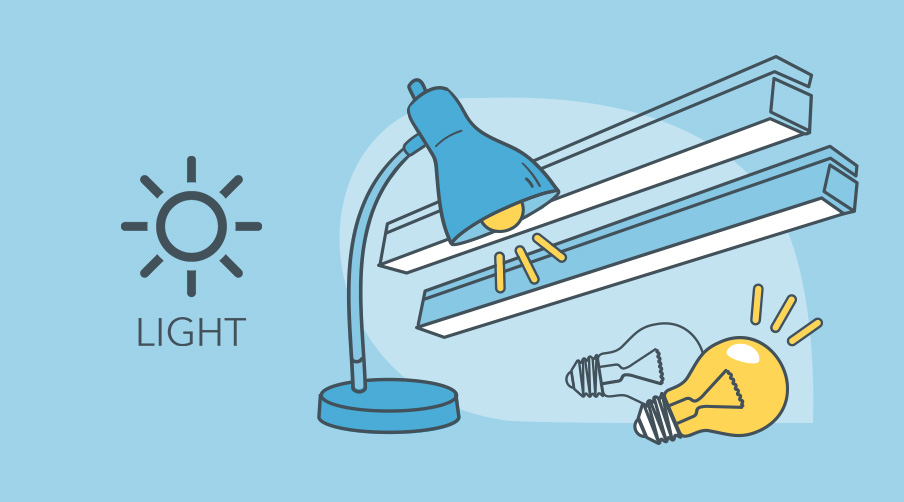Ever thought about how leaving the lights on in your workplace impacts energy costs and work performance?
Lighting buildings unnecessarily has major cost implications and is bad for the environment. It is known as largest single consumer of electricity in commercial buildings1. Monitor to know if lights are left on or off. Then you can adjust based on demand, save money, the planet and pollution.
Contents:
What is light intensity?
Luminous intensity, or light intensity, is the quantity of visible light that is emitted in unit time per unit solid angle. So, it is the capacity of a point light source to provide illumination in a given direction in a building.
For businesses, light intensity is not only an indication of there being enough light to work effectively so that you are alert and productive, light also provides huge potential as an energy saver.
With Airthings for Business, you can monitor light intensity via the Airthings Dashboard or API. Effortlessly check that the light levels are dropping at night, as shown below in an Airthings HQ meeting room. When not in use, why pay for the energy? If the meeting room or workplace has windows, it's likely that there will always be light during the day (as shown below). If it is still high at night, it means the lights are on.

Light pollution and energy wasteage
Often overlooked (no pun intended) light is a huge polluter. It is a huge drain on energy and because we need it to see, it's the easiest thing to go unnoticed.
When in fact, "Energy use in buildings can be split into two basic needs. Thermal energy needs – including space heating and cooling, water heating and cooking – account for around 77% of global final energy demand in buildings". This, as we know is common knowledge and many businesses around the world are seeking to improve their carbon footprint.
What is most interesting though, is that the "remaining 23% is electrical end-uses, which comprise lighting, appliances and other uses unrelated to heating or cooling."2 Of course it depends on your location, type of building and more, but the preface is the same. Wasting energy to power lights that no one needs is unnecessary.


Light intensity and health and wellbeing
The light in a room should allow building occupants to easily orientate and move around. If the lightning in one space is insufficient, it can result in unnecessary eye strain and give rise to symptoms such as eye irritation, fatigue and headache. This happens as a result of poor brightness and contrast, high luminance differences and flickering.
Monitoring light intensity can then reduce the discomfort in commercial buildings, leading to more satisfaction with the indoor environment.
Some of the physical symptoms that building occupants may experience as a result of inadequate light intensity are:
- Eye strain and eye irritation. 3
- Fatigue. 4
- Headache. 5
-1.jpg?width=686&name=Office_dashboard_lifestyle%20(1)-1.jpg)
Why is monitoring light intensity essential for buildings and their occupants?
Wasting energy powering lights that are not in use can be a major drain on energy consumption.
-
Reduce energy costs and save the planet:
 Lighting accounts for 17% of all electricity consumption7 in US commercial buildings, representing the largest single consumer of electricity. 8
Lighting accounts for 17% of all electricity consumption7 in US commercial buildings, representing the largest single consumer of electricity. 8
Some factors that may contribute to these costs are the light intensity, that may be higher than needed, and/or lights kept on during the night accidentally.
Light sensors are an efficient way to know if lights have been unwillingly left on in remote properties. Monitoring light over time can then help understand how to take action to contain energy expenses linked to light. By improving your organization’s sustainability you can also enhance your corporate image and positively engage employees. 9
-
Work performance and headaches:
 If the lighting in a space is insufficient it may influence not only buildings occupants’ comfort, but also their performance. In fact, working with eye irritation, fatigue and headache may not represent the best working condition. Indeed, one study found that when at work with headache, the work performance may be reduced up to 41%. 10 Monitoring light intensity can then help.
If the lighting in a space is insufficient it may influence not only buildings occupants’ comfort, but also their performance. In fact, working with eye irritation, fatigue and headache may not represent the best working condition. Indeed, one study found that when at work with headache, the work performance may be reduced up to 41%. 10 Monitoring light intensity can then help.
Monitoring light usage from the central Airthings dashboard or through the API allows greater oversight and control of energy usage, allowing to remotely check if automatic light systems are working correctly.

Sources
1 https://www.eia.gov/energyexplained/use-of-energy/commercial-buildings-in-depth.php
2 https://www.ren21.net/gsr-2021/chapters/chapter_01/chapter_01/
2.5 Harvard Annual review of public https://www.annualreviews.org/doi/10.1146/annurev-publhealth-031816-044420
3 https://blinkcharlotte.com/newsletter-library/is-office-lighting-affecting-your-vision/#:~:text=Exposure%20to%20harsh%20fluorescent%20lighting,to%20light%20can%20also%20occur.
4 https://www.healthline.com/health/eye-strain-headache#:~:text=One%20uncommon%20cause%20of%20headaches,get%20tired%20due%20to%20overuse.
5 https://blinkcharlotte.com/newsletter-library/is-office-lighting-affecting-your-vision/#:~:text=Exposure%20to%20harsh%20fluorescent%20lighting,to%20light%20can%20also%20occur.
7 https://catalog.data.gov/dataset/commercial-buildings-energy-consumption-survey
8 https://www.eia.gov/energyexplained/use-of-energy/commercial-buildings-in-depth.php
9 https://www.epa.gov/smm/managing-and-reducing-wastes-guide-commercial-buildings
10 https://pubmed.ncbi.nlm.nih.gov/9633720/#:~:text=When%20at%20work%20with%20headache,were%20due%20to%20migrainous%20headaches.
12 https://www.sciencedirect.com/science/article/pii/S036013231930589X
 Most popular
Most popular
 NEW
NEW




 Radon
Radon
 Radon
Radon


.webp)




-1.jpg?width=686&name=Office_dashboard_lifestyle%20(1)-1.jpg)
